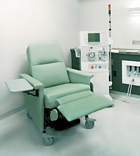
Some skilled nursing facilities have turned to in-house dialysis as a way to drive census, dedicating space and adding equipment that attracts patients with renal failure.
Now, a Centers for Medicare & Medicaid Services policy is aiming to get half of U.S. dialysis patients on home treatment by 2025.
Bloomberg News Thursday outlined a CMS goal to trim $114 billion a year in kidney disease spending, calling it a “belated U.S. embrace of less costly and more convenient technology that other countries have used for years.”
According to NxStage, which recently merged with Fresenius, only about 65,000 of the 480,000 dialysis patients in the U.S. live in skilled nursing settings. But the number of patients with end-stage renal failure is expected to grow by two-thirds through 2025, and many providers have been trying to tap into the market.
For now, reimbursement policies direct most patients toward dialysis centers, including about 5,000 operated by Fresenius and DaVita.
But dialysis centers should be a “last resort” for patients,” Adam Boehler, director of the Center for Medicare & Medicaid Innovation, told Bloomberg. “We want people to have their lives and be able to move and not be tethered.”Bloomberg predicted wider use of home services would drive innovation in the home market, which depends on portable machines similar to the ones some SNFs are using to increase census and reduce transportation costs.
Currently, only 12% of dialysis patients start their treatment at home. It remains to be seen whether, when that percentage grows, the total number of patients in renal failure who ultimately need skilled nursing care for comorbidities could fall.
Concerto Renal Services, which uses traditional machines as the largest provide4r of dialysis in U.S. nursing homes, said the home-first approach could ultimately help SNFs positioned to provide services.C
“Any changes to home dialysis would also apply to SNF dialysis,” said CEO Shimmy Meystel. “It’s going to increase our reimbursement.”




